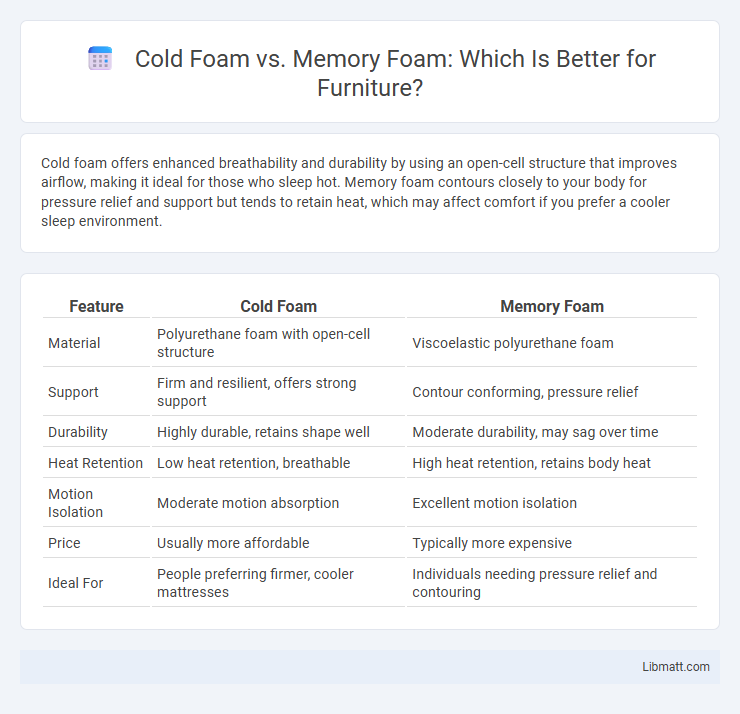Cold foam offers enhanced breathability and durability by using an open-cell structure that improves airflow, making it ideal for those who sleep hot. Memory foam contours closely to your body for pressure relief and support but tends to retain heat, which may affect comfort if you prefer a cooler sleep environment.
Table of Comparison
| Feature | Cold Foam | Memory Foam |
|---|---|---|
| Material | Polyurethane foam with open-cell structure | Viscoelastic polyurethane foam |
| Support | Firm and resilient, offers strong support | Contour conforming, pressure relief |
| Durability | Highly durable, retains shape well | Moderate durability, may sag over time |
| Heat Retention | Low heat retention, breathable | High heat retention, retains body heat |
| Motion Isolation | Moderate motion absorption | Excellent motion isolation |
| Price | Usually more affordable | Typically more expensive |
| Ideal For | People preferring firmer, cooler mattresses | Individuals needing pressure relief and contouring |
Introduction to Cold Foam and Memory Foam
Cold foam is a highly resilient polyurethane foam known for its excellent breathability and support, making it ideal for mattresses and cushions that require durability and airflow. Memory foam, composed of viscoelastic polyurethane, conforms closely to body contours by responding to heat and pressure, providing exceptional pressure relief and comfort. Both foams offer unique benefits, with cold foam excelling in ventilation and structural support while memory foam prioritizes personalized comfort and motion isolation.
Composition and Material Differences
Cold foam is made from open-cell polyurethane with a highly breathable structure that promotes better airflow and temperature regulation, while memory foam consists of viscoelastic polyurethane designed to contour closely to your body by responding to heat and pressure. The durability of cold foam often surpasses memory foam due to its higher resilience and less dense composition, which also contributes to quicker recovery and less sinking. These composition and material differences significantly impact comfort, support, and heat retention, making your choice critical based on sleeping preferences.
Comfort and Support Comparison
Cold foam offers a responsive and breathable structure that adapts quickly to your body shape, providing consistent support and enhanced airflow for a cooler sleep experience. Memory foam contours slowly to your body, delivering deep pressure relief and superior motion isolation, which is ideal for those needing personalized comfort and support. Your choice depends on whether you prioritize temperature regulation and firmness or cushioning and contouring tailored to your body's curves.
Temperature Regulation and Breathability
Cold foam offers superior temperature regulation and breathability compared to memory foam due to its open-cell structure, which allows better air circulation and heat dissipation. Memory foam tends to retain body heat because of its denser composition, potentially causing discomfort during warmer nights. Choosing cold foam enhances Your sleeping comfort by minimizing heat retention and promoting a cooler, more breathable sleep environment.
Durability and Longevity
Cold foam offers superior durability due to its open-cell structure, which resists deformation and maintains firmness over time. Memory foam, while providing excellent contouring and pressure relief, tends to soften and sag faster with prolonged use. Choosing cold foam can enhance the longevity of your mattress by retaining its original support and shape for years.
Hypoallergenic Properties
Cold foam is naturally breathable and resistant to dust mites and allergens, making it an excellent hypoallergenic choice for sensitive sleepers. Memory foam, while contouring to your body, can sometimes trap heat and moisture, potentially harboring allergens if not properly maintained. Choosing cold foam can enhance your sleep environment by reducing allergen exposure and promoting cleaner air quality.
Motion Isolation and Noise Reduction
Cold foam offers superior motion isolation due to its open-cell structure that absorbs and disperses movement efficiently, reducing partner disturbances during sleep. Memory foam excels at noise reduction as its viscoelastic properties minimize creaks and squeaks from mattress motion. Your choice between cold foam and memory foam will impact both motion isolation and noise control based on your specific sleep needs.
Suitability for Different Sleep Positions
Cold foam mattresses provide firm support and excellent pressure relief, making them ideal for back and stomach sleepers who need spinal alignment. Memory foam conforms closely to your body, offering superior contouring and cushioning, which benefits side sleepers by reducing pressure on shoulders and hips. Choosing between cold foam and memory foam depends on your sleep position and the level of support or softness you require for optimal comfort.
Price and Value for Money
Cold foam mattresses typically offer a more affordable option with durable support and good breathability, making them a cost-effective choice for budget-conscious buyers. Memory foam mattresses, while generally priced higher, provide superior contouring and pressure relief, delivering enhanced comfort and long-term value for those prioritizing personalized support. Your decision should consider whether immediate savings or long-term comfort justifies the investment in either cold foam or memory foam options.
Choosing the Right Foam for Your Needs
Cold foam offers excellent breathability and durability, making it an ideal choice for those seeking a cooler sleeping experience and long-lasting support. Memory foam contours closely to the body, providing superior pressure relief and motion isolation, perfect for individuals with joint pain or who share a bed. Consider your comfort preferences, sleeping position, and temperature sensitivity when choosing between cold foam and memory foam mattresses.
cold foam vs memory foam Infographic

 libmatt.com
libmatt.com